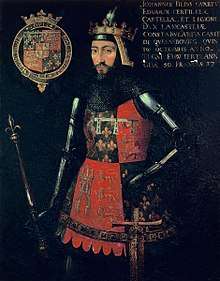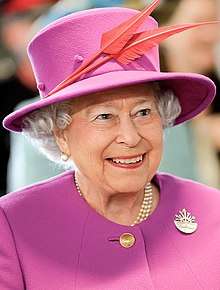Duke of Lancaster
The Duke of Lancaster is the titular owner of the estates of the Duchy of Lancaster and head of the County Palatine of Lancaster. It is also an ancient title that is informally used within Lancaster to describe Elizabeth II, the monarch of the United Kingdom. The Duchy of Lancaster exists as a separate entity from the Crown Estate and currently provides income for the British monarch.[1] The title merged with the crown as a result of the House of Lancaster's participation in the Wars of the Roses.
| Duke of Lancaster | |
|---|---|
| Style | Her Majesty |
| Residence | Buckingham Palace |
| Term length | Life tenure |
| Inaugural holder | Henry IV |
| Formation | 1399 |
| Succession | Charles, Prince of Wales |
| Website | Official website |
| Dukedom of Lancaster Extinct, merged with Crown | |
|---|---|
  Arms of Henry of Grosmont: the arms of his grandfather Edmund Crouchback (arms of King Henry III, a label France of three points) | |
| Creation date | 1351 (first creation) 1362 (second creation) 1399 (third creation) |
| Monarch | Edward III (first creation) Edward III (second creation) Henry IV (third creation) |
| Peerage | Peerage of England |
| First holder | Henry of Grosmont |
| Last holder | Henry V (merged with crown) |
| Subsidiary titles | First creation Earl of Derby Earl of Leicester Earl of Lancaster Earl of Lincoln Earl of Moray Second creation Earl of Richmond Earl of Leicester Earl of Lancaster Earl of Derby Third creation Earl of Chester (subsidiary of Prince of Wales) |
| Extinction date | 1361 (first creation) 1399 (second creation) 1413 (third creation) |
| Former seat(s) | Lancaster Castle |
It is customary at formal dinners in the historic county boundaries of Lancashire and in Lancastrian regiments of the armed forces for the Loyal Toast to the crown to be announced as "The Queen, Duke of Lancaster." In addition, in Lancaster it was quite common as late as the second half of the twentieth century to hear the national anthem sung as "God save our gracious Queen, long live our noble Duke,"[2][3][4][5] but this is a tradition that has no constitutional warrant, and the British monarch is not styled legally so within either the County Palatine of Lancashire nor the Duchy of Lancaster in any official capacity (for example, Letters Patent or Acts of Parliament), merely as a sign of local, 'Lancastrian' loyalty.
History
There were several Dukes of Lancaster in the 14th and early 15th centuries. There were three creations of the Dukedom of Lancaster. The first creation was on 6 March 1351, for Henry of Grosmont, 4th Earl of Lancaster, a great-grandson of Henry III; he was also 4th Earl of Leicester, 1st Earl of Derby, 1st Earl of Lincoln and Lord of Bowland. He died in 1361 and the peerage expired.
The second creation was on 13 November 1362, for John of Gaunt, 1st Earl of Richmond,[6] who was both Henry Grosmont's son-in-law and also third surviving son of King Edward III. John had married Blanche of Lancaster, 6th Countess of Lancaster, daughter of Henry Grosmont and heiress to his estates. When John of Gaunt, the 1st Duke of this creation died on 4 February 1399, the Dukedom passed to his son, Henry of Bolingbroke, 1st Duke of Hereford. Later that same year, the new 2nd Duke usurped the throne of England from Richard II, ascending the throne as Henry IV, at which point the Dukedom merged in the Crown (i.e. becomes vested with the Crown).
The third creation was on 10 November 1399, for Henry of Monmouth, Prince of Wales, eldest son of the new king. In 1413, the 1st Duke ascended the throne as King Henry V, and the Dukedom merged in the crown again, where it has remained ever since.
First creation, 1351-1361
| Duke | Portrait | Birth | Marriages | Death |
|---|---|---|---|---|
| Henry of Grosmont House of Plantagenet also Earl of Derby (1337), Earl of Leicester (1345), Earl of Lancaster (1345), Earl of Lincoln (1349), Earl of Moray (1359), Lord of Beaufort and Nogent (1345) | %2C_f.8_-_BL_Stowe_MS_594_(cropped).jpg) | c. 1310 Grosmont Castle son of Henry, 3rd Earl of Lancaster and Maud Chaworth | Isabel of Beaumont c. 1337 2 children |
23 March 1361 |
| Henry of Grosmont died in 1361 without male issue. | ||||
Second creation, 1362-1399
| Duke | Portrait | Birth | Marriages | Death |
|---|---|---|---|---|
| John of Gaunt House of Lancaster (founder) also Duke of Aquitaine (1390), Earl of Richmond (1342–1372), Earl of Leicester, Earl of Lancaster, Earl of Derby, Baron of Halton (1361) |  | 6 March 1340 Ghent son of Edward III and Philippa of Hainault | Blanche of Lancaster 19 May 1359 – 12 September 1368 8 children Constance of Castile 21 September 1371 – 24 March 1394 2 children Katherine Swynford 13 January 1396 4 children |
3 February 1399 |
| Henry Bolingbroke House of Lancaster also Duke of Hereford (1397), Earl of Northampton (1337) | .jpg) | c. April 1367 Bolingbroke Castle son of John of Gaunt and Blanche of Lancaster | Mary de Bohun c. 1381 – 4 June 1394 6 children Joan of Navarre 7 February 1403 no children |
20 March 1413 |
| Henry Bolingbroke seized the throne in 1399 as Henry IV, and all of his titles merged with the crown. | ||||
Third creation, 1399-1413
| Duke | Portrait | Birth | Marriages | Death |
|---|---|---|---|---|
| Henry of Monmouth House of Lancaster also Prince of Wales and Earl of Chester (1399), Duke of Cornwall (1337), Duke of Aquitaine (1390) | 16 September 1386 Monmouth Castle son of Henry IV and Mary de Bohun | Catherine of Valois 2 June 1420 1 child |
31 August 1422 | |
| Prince Henry succeeded as Henry V in 1413 upon his father's death, and his titles merged with the crown. | ||||
Family tree
| King Henry III (1207–r.1216–1272) | |||||||||||||||||||||||
| EARL OF LANCASTER, 1267 | |||||||||||||||||||||||
| King Edward I (1239–r.1272–1307) | Edmund Crouchback, 1st Earl of Lancaster (1245–1296) | ||||||||||||||||||||||
| King Edward II (1284–r.1307–1327) | Thomas of Lancaster, 2nd Earl of Lancaster (1278–1322) | Henry of Lancaster, 3rd Earl of Lancaster (1281–1345) | |||||||||||||||||||||
| DUKE OF LANCASTER, 1351 | |||||||||||||||||||||||
| King Edward III (1312–r.1327–1377) | Henry of Grosmont, 4th Earl, 1st Duke of Lancaster (c.1310–1361) | ||||||||||||||||||||||
| DUKE OF LANCASTER, 1362 | |||||||||||||||||||||||
| John of Gaunt, 5th Earl, 1st Duke of Lancaster (1340–1399) | Blanche of Lancaster (1345–1368) | ||||||||||||||||||||||
| Henry Bolingbroke, 6th Earl, 2nd Duke of Lancaster King Henry IV (1367–r.1399–1413) | |||||||||||||||||||||||
| DUKE OF LANCASTER, 1399 | |||||||||||||||||||||||
| Henry of Monmouth, 1st Duke of Lancaster King Henry V (1386–r.1413–1422) | |||||||||||||||||||||||
| King Henry VI (1421–1471, r.1422–61, 1470–71) | |||||||||||||||||||||||
See also
- Earl of Lancaster
- List of titles and honours of the British Monarch#Customary titles
References
- "HM The Queen, Duke of Lancaster". Duchy of Lancaster. Retrieved 25 December 2019.
- Armecin, Catherine (13 October 2019). "Queen Elizabeth II's Titles Shockingly Include 'Duke,' 'Lord' Despite Being Female". International Business Times.
- Kretschmer, Anna (13 October 2019). "The Queen's surprising ancient titles revealed - and why her main title causes controversy". Daily Express.
- "The Reverend John Williams". The Daily Telegraph. 24 December 2003.
- Tulloch, Alexander (2013). The Little Book of Lancashire. Stroud, Gloucestershire: History Press. p. 86. ISBN 978-0-7524-9746-4.
- "Duchy of Lancaster". Lancaster Castle. Retrieved 25 December 2019.
External links
- Duchy of Lancaster website – Duke of Lancaster
- "Of the Countries Subject to the Laws of England," from Commentaries on the Laws of England, Introduction, chapter 4, by Sir William Blackstone, 1765 (see text following footnote 72)
